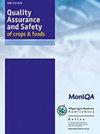季铵壳聚糖、聚乙烯醇和荔枝果皮提取物活性包装膜的研制
IF 5.3
3区 农林科学
Q1 FOOD SCIENCE & TECHNOLOGY
引用次数: 16
摘要
荔枝(Litchi chinensis Sonn.)果皮含有丰富的多酚类物质,是制备活性包装薄膜的理想材料。本研究将1 wt%、3 wt%和5 wt%的荔枝皮提取物(LPE)分别加入到季铵盐壳聚糖(QAC)和聚乙烯醇(PVA)基质中,制备活性包装膜。比较了QAC-PVA (QP)薄膜与LPE (QP-LPE薄膜)和无LPE (QP薄膜)的结构、物理和功能性能。结果表明,QP膜具有均匀的横截面,而QP- lpe膜具有粗糙和不均匀的横截面。加入LPE后,由于LPE与膜基质之间形成分子间相互作用,QP膜的N-H、O - h、C - h和C=O拉伸带发生位移。LPE使无色QP膜变为褐色。QP- lpe薄膜的紫外可见光透过率低于QP薄膜。加入LPE后,膜厚从0.091增加到0.103 mm,膜的水蒸气透性从14.98 × 10−11增加到17.21 × 10−11 g m−1 s−1 Pa−1,膜的透氧性从0.16增加到0.22 cm3 mm m−2 day−1 atm−1,膜的抗拉强度从14.10增加到17.41 MPa,膜的断裂伸长率从36.94%下降到25.13%。QP-LPE膜在蒸馏水中4 h内迅速释放出多酚类物质,并表现出较强的抗氧化活性。添加LPE后,膜对大肠杆菌、鼠伤寒沙门菌、金黄色葡萄球菌和单核增生李斯特菌的抑菌率由50.40 ~ 68.04%提高到58.93 ~ 91.38%。结果表明,QP-LPE薄膜可作为食品工业的抗氧化和抗菌包装材料。本文章由计算机程序翻译,如有差异,请以英文原文为准。
Development of active packaging films based on quaternary ammonium chitosan, polyvinyl alcohol and litchi (Litchi chinensis Sonn.) pericarp extract
Litchi (Litchi chinensis Sonn.) pericarp contains abundant polyphenols that are suitable materials for developing active packaging films. In this study, 1 wt%, 3 wt% and 5 wt% of litchi pericarp extract (LPE) was added into qua-ternary ammonium chitosan (QAC) and polyvinyl alcohol (PVA) matrix to develop active packaging films. The structural, physical and functional properties of QAC-PVA (QP) films were compared with LPE (QP-LPE films) and without LPE (QP films). Results showed QP film had a heterogenous cross-section whereas QP-LPE films displayed rough and uneven cross-sections. After adding LPE, the N–H, O–H, C–H and C=O stretching bands of QP films shifted due to the formation of intermolecular interactions between LPE and film matrix. LPE made the colorless QP film turned brown. QP-LPE films presented lower ultraviolet–visible light transmittance than QP film. After adding LPE, film thickness increased from 0.091 to 0.103 mm, film water vapor permeability increased from 14.98 × 10−11 to 17.21 × 10−11 g m−1 s−1 Pa−1, film oxygen permeability increased from 0.16 to 0.22 cm3 mm m−2 day−1 atm−1, film tensile strength increased from 14.10 to 17.41 MPa, and film elongation at break decreased from 36.94% to 25.13%. QP-LPE films quickly released polyphenols in distilled water within 4 h and displayed potent antioxidant activity. The antimicrobial ratio of the film against Escherichia coli, Salmonella typhimurium, Staphylococcus aureus and Listeria monocytogenes was elevated from 50.40−68.04% to 58.93−91.38% after adding LPE. Results suggested QP-LPE films could be utilized as antioxidant and antimicrobial packaging materials in food industry.
求助全文
通过发布文献求助,成功后即可免费获取论文全文。
去求助
来源期刊

Quality Assurance and Safety of Crops & Foods
FOOD SCIENCE & TECHNOLOGY-
CiteScore
4.60
自引率
7.50%
发文量
61
审稿时长
1 months
期刊介绍:
''Quality Assurance and Safety of Crops & Foods'' is an international peer-reviewed journal publishing research and review papers associated with the quality and safety of food and food sources including cereals, grains, oilseeds, fruits, root crops and animal sources. It targets both primary materials and their conversion to human foods. There is a strong focus on the development and application of new analytical tools and their potential for quality assessment, assurance, control and safety. The scope includes issues of risk assessment, traceability, authenticity, food security and socio-economic impacts. Manuscripts presenting novel data and information that are likely to significantly contribute to scientific knowledge in areas of food quality and safety will be considered.
''Quality Assurance and Safety of Crops & Foods'' provides a forum for all those working in the specialist field of food quality and safety to report on the progress and outcomes of their research.
 求助内容:
求助内容: 应助结果提醒方式:
应助结果提醒方式:


